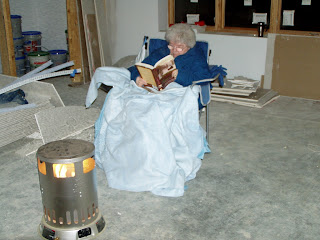We got the gas lines finished up, and I had my gas line inspection. The plumber that helped with the test, was impressed we were holding 70 pounds of pressure with the quality of the black iron piping he has been seeing. The inspector commented that he was bored since the pressure gauge was not moving any, and with that he signed off on my inspection.
We got the air intake for the water heater run out through the garage and connected out through the wall.
On the left is the air intake for the water heater, the other PVC vents the gases the batteries produce, and the black metal pipe is what the propane will flow through to the appliances in the house.
We got the last 4 panels mounted. I haven't had the chance to get them wired into the system yet.
We also got the fan mounted in the vent house, and the filters installed. It is hooked up to a breaker in the house, and if I want to bring in fresh air, I flip a switch, and it starts up. Last weekend we had it running for a while. It was 45 outside, and the air coming into the house was 52. The real test will be when it is freezing outside, and I want to bring in fresh air. Then I will see how well this will work.
I got the large wires running from the batteries to the power panel, "organized". The problem is when you have a wire that is too long, but you can't cut it, and it is very heavy, what do you do with it? Make modern art?
It looks like a mess, but I was very careful in how I routed them. Still, there is only so much you can do with them, they are quite unwieldy.
I got the permanent drainage installed for the underground conduits. The tubing drains to the floor drain off to the right. On the left I will be connecting other drain lines on from the heat recovery ventilator, and my water to air heat exchanger. I am not expecting condensation off the water to air heat exchanger until into the spring or summer when I plan to draw heat from the incoming air, and put it in the floor.
I also ran the drain for the air intake for the water heater. They want a drain so that any moisture that condenses in the air intake, has a way out other than through the combustion chamber.
Drains going to the floor drain, water heater gas line is connected, ready for gas.
After I passed my inspection, and had my valves installed and my water heater connected, I got a hold of the propane company, and got them to finish the gas line hookup. They literally hung the pressure regulator off the end of the pipe. Dad went out and supervised the final hookup.
While he was waiting for the propane guys to show up, and then after it as well, he and mom worked on running some of the plumbing line. They got the lines for the kitchen and the master bath run from the respective rooms, back to the utility room.
We got the rest of the conduit runs out in the garage put up. I have one conduit running into the utility room for the DC power for my pumps, and one for the AC that will go to the house breaker panel.
I wanted to have my plumbing lines well insulated. So I started to insulate the lines all the way from where they would come out of the manifolds, to where they would go to the fixtures.
This last weekend, we continued working on the plumbing.
We had to build an arrangement to turn off the well pump when my tank is full. We constructed a support structure for the switch and the float rod that goes into the tank and connects to the float.
We got the plumbing from the water conditioner to the holding tank and through the pressure pump complete. I went ahead and powered up the well pump and pumped for a while.
Here you can see the arrangement of the holding tank, the pressure tanks, the water conditioner, and the water heater. I am filling up the one wall of my utility room very quickly.
My hope is that by the end of this week, I will have the pressure tanks plumbed in, and be able to have "running" water from a drain outlet off of them. Hopefully by the beginning of the year, I will be able to fire up the water heater.
Hope you all have a merry Christmas, and a happy and safe new year.


























